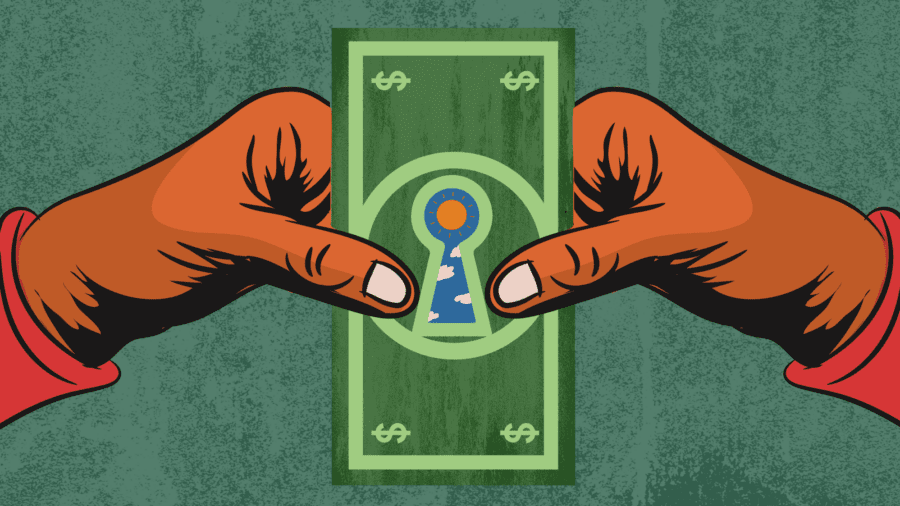
A Beginner’s Guide to Saving for Your Dream Retirement (Even If It’s Decades Away!)
Did you know that, according to the Federal Reserve, 25 percent of Americans have no retirement savings at all?
Life moves fast. Before you know it, you will be approaching your retirement and ready to travel, go golfing, and get the much-deserved rest you need. No individual can resist the movement of time, so the only real strategy you have is to prepare for it.
This means you need to be thinking about retirement right now, no matter how old you are. It’s never too late or too early to start setting aside money for your retirement fund! In fact, two-thirds of non-retired Americans are concerned that they will not meet their financial retirement goals. It’s no secret that preparing for retirement can be challenging. However, don’t let these statistics discourage you.
No matter if you’ve already begun saving or if you haven’t started the process at all, this article will provide a beginner’s guide to saving for your dream retirement so that you can be prepared to live out the best days of your life when the time comes. Let’s get into it!
Getting Started on Your Retirement Journey
A consistent theme among those who do not save is that they simply cannot afford to do so. Of course, it’s not smart to stop paying your bills or default on your loans, but even investing your spare change now can make a difference years down the road.
Let’s be honest, there will be times when money is tight and savings are minimal. Because of times like these, you may have fewer investment opportunities available to you. Don’t get down on yourself! Rather, save as much as you can as often as you can.
Don’t Be Afraid To Start Small
The personal finance industry is skewed toward the wealthy, and most financial institutions would rather do business with ten clients worth $10 million than 10,000 clients worth $1,000 each. However, your retirement and savings plans should be based on what works best for you, not the financial experts.
That being said, putting away $250 or $500 is a good place to start your retirement fund. The act of saving anything helps form a routine and a system, so don’t worry about the dollar amount when you’re just getting started. In fact, multiple brokers now provide retirement accounts with no minimum balance and no monthly maintenance fees.
Putting away money regularly is the most effective way to prepare for retirement, so it’s important that maintaining this practice becomes a priority for the rest of your life.
To put it plainly, doing so aids in ensuring your future success. Set aside some money each month, preferably in a digital savings account, and only use it for true emergencies. The majority of these digital wallets allow you to set up recurring monthly payments from your main savings account. Payroll deductions can also be set up for a 401(k) plan if your company offers one.
How to Choose the Right Brokerage Firm for Your Retirement Investments
There are a number of large, nationally recognized brokerage and mutual fund firms that are willing to accept investors with smaller investment amounts and no account minimums or fees. It may be wise to open accounts with these larger institutions as they typically offer the lowest, most understandable fees and the greatest variety of investment vehicles (mutual funds, exchange-traded funds, or ETFs).
In addition, these sizable businesses have the resources to cater to your evolving needs, which may one day include the hiring of a personal investment advisor.
Choosing wisely is essential, so don’t rush this process because switching investment firms too often can eat into your savings because each institution charges fees to handle account transfers. Check out the costs and the options for exchange-traded funds (ETFs) and mutual funds (MFs).
Focus less on the trading tools and services they offer and more on your savings goal as you begin your investment journey; trading is not a good use of limited funds in your early stages of investment.
Understand That There Are Always Risks
Those just starting to put money away for retirement should also consider the risk of their investments. Before taking the plunge into a new investment, ask yourself, How likely is it that I’ll lose a sizable chunk of my savings?
You should assume a reasonable level of risk if you are just starting out as a saver or investor. While some savings is better than none, it won’t be enough to support your current lifestyle if you only put away a few hundred dollars a month.
Because of this, it is not advisable to put money into fixed income or other conservative investments like savings accounts as your primary investment strategy. Similarly, you wouldn’t want to put your initial savings in a high-risk investment like biotech, bitcoin, gold, leveraged funds, and so on.
Your first step should be to invest in a simple index fund (a fund that tracks a widely followed index, like the Dow Jones Industrials or the S&P 500). While a decline in value is always possible, the likelihood of a complete loss is extremely low and suggests that growth of some kind is likely.
The Difference Between ETFs and Mutual Funds for New Investors
These are great for beginners because you can invest any size sum, from a few dollars to tens of thousands, in an ETF or mutual fund with minimal effort and expense. You can spread out your risk and increase your potential for profit by investing in a mutual fund or ETF rather than making hundreds of individual stock purchases with $500.
It’s no secret that index ETFs have been trending upward in recent years. An investor can effectively purchase stock in the entire S&P 500 or other popular indexes for the cost of a commission and a small annual fee paid in cash or automatically deducted from the shares themselves. Even though mutual fund investors have had access to broad investment categories like “growth” and “value” for decades, a growing number of ETFs now offer this same opportunity.
However, mutual funds are also useful in some circumstances. Mutual funds typically offer investors the advantage of having their money actively managed by a professional who makes decisions on a daily basis in an effort to maximize returns. Most ETFs, on the other hand, are fully automated, holding a predetermined basket of stocks (typically matching an index) and only rebalancing when the index does.
Consider both the mutual fund’s performance and its fees and expenses when making a decision. You should look for a fund that has not only outperformed its competitors in the long run but has also suffered less severe losses during market downturns.
Join In 200 Million+ On The Journey to Greatness
The Most Common Retirement Funds
It’s essential to be aware of the most common types of retirement funds so that you know the options you have available. Many different funds offer different benefits and can be more optimal for your lifestyle and income.
401(k)
Many companies now provide their employees with 401(k) plans, a type of defined-contribution pension. Employees can make tax-deductible contributions to the 401(k), and their employers may even match a portion of those contributions.
Unlike traditional investment accounts, 401(k) funds grow tax-deferred, meaning that you won’t have to pay taxes on your contributions or the earnings on those contributions until you begin withdrawing the funds, likely at a time when your tax rate is lower.
Traditional IRAs
Your contributions to a traditional IRA are made before taxes, so your retirement savings grow tax-free. There are some restricted asset classes that cannot go into an IRA, such as precious metals and real estate, but an IRA can be opened with a brokerage firm, and you can buy and sell securities like stocks, ETFs, bonds, and mutual funds through this investment account.
Roth IRAs
Roth IRA contributions are made with after-tax money rather than before-tax money. Then, instead of deferring taxes as they grow, investments are not taxed at all. The annual contribution limit for a Roth IRA is the same as that for a traditional IRA, but there are income restrictions for Roth IRAs. If you file taxes as a single person, your Modified Adjusted Gross Income (MAGI) must be under $140,000 for the tax year 2021 and under $144,000 for the tax year 2022 to contribute to a Roth IRA.
SEP and SIMPLE IRA
Additional retirement plan choices are available to those who are self-employed or who run their own small businesses. Simplified Employee Pension Individual Retirement Accounts (SEP IRAs) enable businesses of any size to make tax-deductible contributions to their workers’ and owners’ retirement funds. A SEP IRA is an individual retirement account to which only employers, including the self-employed, are eligible to make contributions.
“Savings Incentive Match Plan for Employees” is the acronymic name for SIMPLE IRAS, and to establish one, a company must have fewer than one hundred workers.
It is possible to make contributions to a SIMPLE IRA using one of two different methodologies.
An organization that hires individuals can either match an employee’s annual contribution by 3 percent or set up a non-elective 2 percent contribution of each employee’s salary without requiring employee contributions.
There are a variety of ways to save money in addition to traditional retirement accounts. In order to avoid paying taxes on your savings, the government imposes annual limits and other regulations. However, the amount you can save in a regular taxable brokerage account is unrestricted. Even though you may have to pay taxes on your dividends and your capital gains, it is still possible to save money and amass wealth through these methods.
The Most Important Things to Consider When Saving for Retirement
There’s so much that goes into saving for retirement that it can become overwhelming if you’re just starting out. Don’t let that stop you! The most crucial thing you can do in the whole process is to just start saving now. Once you do that, you should keep these additional tips in mind.
Invest With The Proper Risk Profile
Risk-averse investors should be aware that the longer they have to save for retirement, the more aggressive their portfolio can afford to be. Then, as retirement time draws near, switch to more conservative allocations. These risk adjustments can be made automatically for you over time by investing in a mutual fund with a target date.
Diversify, Diversify, Diversify
Don’t risk everything on a single venture; spread your investments out. Diversification is essential for maximizing expected returns while minimizing risk. Over-investing in company stock in a 401(k) is a common mistake when saving for retirement. Holding a modest amount of company stock is fine, but doing so can expose you to unnecessary risk.
Take Advantage of Employer Contributions
Employer contributions that are matched are essentially free money, so why let that go to waste? Make the most of this perk if you can. To achieve this, you may need to increase your personal contribution.
Automate Your Retirement Savings
Don’t risk forgetting to save for retirement. Instead, set up automatic withdrawals to be made each week or month. Since investing when stocks are down can mean buying at deep discounts when they bounce back, automating also keeps your emotions in check when markets become volatile.
Remain Vigilant and Don’t Get Discouraged
After all is said and done, the very first and most critical step in saving for your retirement is to begin. There is no single best way to save or invest your money, and it’s inevitable that you’ll make some blunders along the way, leading to a decline in the value of some or all of your assets at some point.
Though undesirable, this is actually quite normal. What matters is that you keep putting money aside, expanding your knowledge, and planning for financial security in the future. If you can get into the routine of setting aside money every month, investing it wisely, and giving it time to grow, you will be well on your way to a more secure financial future, no matter what age you are.
Greatness Authors
Greatness Authors is a collection of writers, thinkers, curiosity experts, and students of the world who are committed to bringing you the most up-to-date, impactful, and inspiring information surrounding Greatness topics.

Before You Retire, Ask Yourself These 7 Financial Questions to Make Sure You’re in the Clear

The *New* Way to Market Your Business on YouTube & Best Practices for Higher Engagement

The Power of Masterminds to Grow Your Business and How to Find One Near You

4 Inspirational Stories That Prove Money Isn’t the Key to Happiness

A Beginner’s Guide to Building a Great Credit Score While Avoiding Debt and Common Credit Mistakes










